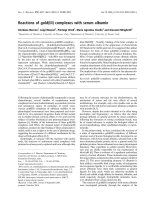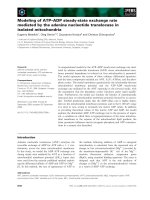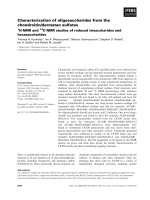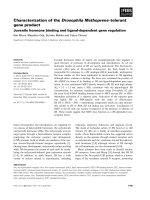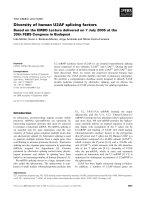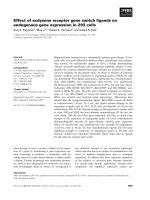Báo cáo khoa học: "Characteristics of equine summer eczema with emphasis on differences between Finnhorses and Icelandic horses in a 11-year study" pdf
Bạn đang xem bản rút gọn của tài liệu. Xem và tải ngay bản đầy đủ của tài liệu tại đây (481.12 KB, 6 trang )
BioMed Central
Page 1 of 6
(page number not for citation purposes)
Acta Veterinaria Scandinavica
Open Access
Research
Characteristics of equine summer eczema with emphasis on
differences between Finnhorses and Icelandic horses in a 11-year
study
Raija E Hallamaa
Address: Veterinary Clinic, Pisteenkaari 4, 03100 Nummela, Finland
Email: Raija E Hallamaa -
Abstract
Summer eczema, allergic dermatitis of the horse, was studied on 275 affected horses in Finland in
1997–2007. Features of the horses, clinical signs of the disease and owners' opinions of aggravating
factors were recorded. Differences, especially, between two of the native Scandinavian horse
breeds, the Finnhorse and the Icelandic horse, were evaluated. The study was based on clinical
examination and information from the owners. Of the horses, 50% were Finnhorses, 26% Icelandic
horses and 24% consisted of different breeds of ponies and other horses. Of the Finnhorses, 76%
had summer eczema by the age of 5 years, but in the Icelandic horses born in Finland the average
age at onset was 7 years. The vast majority of the horses, 75%, had moderate clinical signs, while
16% showed severe and 9% mild. The severity of clinical signs did not depend on the duration of
the disease nor was it related to the age at onset. The only linkage to severity was the breed of the
horse or import from Iceland; New Forest ponies and imported Icelandic horses showed severe
clinical signs significantly more often than Finnhorses. Of the owners, 38% regarded insects as the
only aggravating factor, 24% mentioned several simultaneous factors, including grass fodder and
sunlight, while 22% could not specify any. In Finland, a typical horse breed suffering from summer
eczema is the Finnhorse and the characteristics of the disease are mainly uniform with the other
breeds affected. Equine summer eczema seems to be aggravated by various combinations of
environmental factors.
Introduction
Summer eczema (Queensland itch, sweet itch) is a season-
ally recurring allergic skin disease of the horse. It is the
most common allergic skin disease and one of the com-
monest dermatologic diagnoses in the horse [1,2]. The
aetiology is usually associated with biting insects, espe-
cially species of Culicoides [1,3], and therefore the disease
is also called insect hypersensitivity or insect bite hyper-
sensitivity, IBH [4,5]. A typical clinical sign is pruritus
with following skin lesions and secondary infections (Fig.
1). The mane and tail are most commonly affected, how-
ever, horses with severe signs may have lesions on large
areas of the entire body [6,7]. A diagnosis is based on clin-
ical examination and typical, seasonally occurring signs
[2,5,8,9]. Differential diagnoses are parasitic skin diseases,
dermatophytosis and other allergic diseases [1]. Summer
eczema is common in Icelandic horses which are exported
and thus have not been exposed to bites of insects before
import [6-8,10]. The main aim of treatment is to mini-
mize contact with insects and relieve allergic symptoms.
Published: 14 July 2009
Acta Veterinaria Scandinavica 2009, 51:29 doi:10.1186/1751-0147-51-29
Received: 14 February 2009
Accepted: 14 July 2009
This article is available from: />© 2009 Hallamaa; licensee BioMed Central Ltd.
This is an Open Access article distributed under the terms of the Creative Commons Attribution License ( />),
which permits unrestricted use, distribution, and reproduction in any medium, provided the original work is properly cited.
Acta Veterinaria Scandinavica 2009, 51:29 />Page 2 of 6
(page number not for citation purposes)
Insecticides, special blankets, antihistamines, glucocorti-
coids or an autogenous serum preparation have been used
[1,2,11]. However, treatment is challenging.
The aim of this study was to summarize the features of
equine summer eczema in a long-standing study, espe-
cially on the Finnhorse, the native Finnish horse breed,
and the Icelandic horse and to compare the findings, also
with other breeds affected. Additionally, owners' opinions
of aggravating factors were delineated.
Materials and methods
In total, 275 horses suffering from typical, seasonally
occuring signs of equine summer eczema entered this
study during 1997–2007. Horses were from different
regions of Finland and the annual number of new patients
varied from 11 to 45. The study consisted of horses whose
owners or local veterinarians contacted the author due to
summer eczema. The diagnosis was based on a clinical
examination by the author or by local veterinarians. Only
horses which had clinical signs during thermal summer
(the mean temperature of day above +10°C) were
included, while horses with pruritic signs before or after
this summer season were excluded.
Data of the horses and the disease
Information on the horses, including breed, age, sex,
country of birth and time of import to Finland, was
acquired by questionnaire and interviews. In addition,
features of the disease were recorded: the age at outbreak,
duration of the disease and severity of clinical signs. Own-
ers' opinions concerning aggravating factors were also
recorded without using any proposed list of alternatives.
The clinical signs were categorised by the author as mild,
moderate or severe. Signs were regarded as mild, if pruri-
tus in the mane, tail or body, was the only symptom. Pru-
ritus with mild skin affection in the mane, tail and/or
body, was classified as moderate signs, while horses with
pruritus and large regional skin lesions in the mane, tail
and body were graded as having severe clinical signs (Fig.
1). In addition, the first and last contact of the owners
relating to symptoms of summer eczema and the excep-
tionally cold, rainy or dry periods in each summer season
were recorded by the author. Full data of all the horses was
not possible to get, especially, when a horse had had
many previous owners. Hence the numbers of horses vary
in different variables and are then presented in parenthe-
ses.
Statistical analyses
The differences between the qualitative variables with
non-parametric distribution were evaluated by Fisher's
exact test. The t test was used when the differences
between the quantitative variables with parametric distri-
bution were analysed. One way analysis of variance was
used, when the relation between the age of outbreak or
duration of disease and severity of clinical signs was
assessed. Two sided P-values < 0.05 were considered sig-
nificant. In all tests, StatsDirect statistical software pro-
gram (StatsDirect Ltd, Sale, Cheshire, UK) was used.
Results
The 275 horses which entered the study consisted of 139
Finnhorses, 71 Icelandic horses, 45 ponies, 12 horses of
different breeds and 8 horses whose breed was not known
(Table 1). All 139 Finnhorses were born in Finland. Of the
Icelandic horses, 56 were born in Iceland, 11 in Finland,
while the origin of 4 horses remained unknown. In the
group of ponies, Shetland and New Forest ponies were the
commonest breeds, both of them represented 33% of the
affected ponies, while all the rest were of different pony
breeds (Table 1).
Of the horses, 48% were female and 52% male; geldings
and stallions formed 82% and 18%, respectively. The
mean age of the horses was 9.3 ± 4.5 years (range 1–25).
The average age at onset was 6.1 ± 4.1 years (range 0.5–22,
n = 202). The detailed information on the age at onset or
Finnhorse with severe clinical signs of summer eczemaFigure 1
Finnhorse with severe clinical signs of summer
eczema.
Acta Veterinaria Scandinavica 2009, 51:29 />Page 3 of 6
(page number not for citation purposes)
the duration of the disease in the commonest breeds
affected is presented in Table 1 and illustrated in
Finnhorses in Figure 2. In the Icelandic horses born in Fin-
land, the mean age at onset was 6.9 ± 4.4 years (range 2–
15) and, however, did not significantly differ from the age
of the Finnhorses (P = 0.0611). Of the imported Icelandic
horses, 74% developed summer eczema by the third sum-
mer after export (mean 3.0 ± 2.2 summers, range 1–7).
When the horses entered this study, they had suffered
from summer eczema for approximately 3.3 ± 2.4 years
(range 1–13 years, n = 217, Table 1). Of the horses, 81%
had had symptoms during two consecutive summers or
more.
The severity of clinical signs varied from mild to severe;
9% of the horses had mild, 75% moderate and 16% severe
signs. Horses with mild clinical signs had suffered from
the disease for approximately 2.6 ± 1.8 years, horses with
moderate signs 3.5 ± 2.5 years and horses with severe
signs 2.8 ± 1.8 years. No significant association was found
between the duration and the severity of the disease. The
mean age of the outbreak in the horses with mild signs
was 5.4 ± 3.9 years, with moderate 6.2 ± 4.0 and with
severe 6.3 ± 4.5. In the Finnhorses, the respective values
were 4.7 ± 3.6, 4.6 ± 3.6 and 4.1 ± 4.2 years. The age at
outbreak did not show significant relation to the severity
of clinical signs; neither in the whole group of horses nor
in the Finnhorses. No significant difference in the severity
of signs could be found between male and female horses.
The severity of clinical signs in the most commonly
affected breeds in the study is presented in Table 2. Icelan-
dic horses showed significantly more often severe clinical
signs than Finnhorses (P = 0.0295). When imported Ice-
landic horses and Icelandic horses born in Finland were
evaluated separately, the former group had significantly
more commonly (P = 0.0183) severe signs than the
Finnhorses, whereas the latter group did not (P = 0.6176).
No significant difference was found in the severity of the
disease between imported Icelandic horses and Icelandic
horses born in Finland. An exceptionally high proportion
of the New Forest ponies showed severe clinical signs
(Table 2); significantly more than of the Finnhorses (P =
0.0082). Of the 15 New Forest ponies, 12 were born in
Finland and the difference was also significant (P =
0.0186) between these ponies and Finnhorses. However,
New Forest ponies did not show significantly more often
severe signs as compared with Icelandic horses, whether
or not imported. The severity of the disease in Shetland
ponies did not differ from that of the Finnhorses.
Typically, most of the horses showed clinical signs from
May to October. However, the time of onset varied; some
of the horses had signs already from May, while others
showed no signs until in the late summer. The mean
period when owners annually took contact due to sum-
mer eczema was 147 ± 15 day, i.e. approximately five
months. All the horses had been exposed to sunlight and
biting insects and most of the horses had been kept on
pasture. Of the owners (n = 241), 64% regarded biting
insects as one of the aggravating factors, 19% mentioned
grass fodder and 12% sunlight, while 22% of the owners
could not specify any single factor. Insects were regarded
Table 1: Breed distribution, age at onset and duration of disease in 275 horses suffering from summer eczema in Finland.
Breeds Number of horses Age at onset Duration of disease
mean ± sd/years mean ± sd/years
Finnhorse 139 (50.5%) 4.6 ± 3.6 3.6 ± 2.7
Icelandic horse 71 (25.8%) 9.0 ± 2.9 3.0 ± 1.9
Shetland pony 15 (5.5%) 3.8 ± 3.1 3.5 ± 1.2
New Forest pony 15 (5.5%) 4.5 ± 3.6 3.7 ± 2.5
Trakehner 3 (1.1%)
Finnish warmblood 3 (1.1%)
Russ pony 3 (1.1%)
Welsh Mountain pony 2 (0.7%)
Andalusian 1 (0.4%)
Cob 1 (0.4%)
Friesian 1 (0.4%)
Huzu pony 1 (0.4%)
Welsh pony 1 (0.4%)
Pony, undefined breed 8 (2.9%)
Warmblood horse, undefined 3 (1.1%)
Breed not known 8
Total 275
Age at onset and duration of disease are listed in the commonest breeds affected.
Acta Veterinaria Scandinavica 2009, 51:29 />Page 4 of 6
(page number not for citation purposes)
as the only aggravating factor by 38% of the owners, grass
fodder 5% and sunlight 2%. Of the owners, 24% men-
tioned several aggravating factors. Regarding grass fodder,
some of the owners mentioned that the species Trifolia or
heavily used fertilizers seemed to aggravate clinical signs.
When the weather conditions were evaluated, 15% of the
owners answered that signs were aggravated in sunny or
hot and humid weather. No other weather condition was
mentioned to have marked influence on aggravation.
Discussion
The vast majority of the affected horses were Finnhorses.
The Finnhorse is a native Finnish coldblood horse breed
and it has been officially bred in Finland for 100 years.
During the 11-year period of the study, the average
number of Finnhorses in Finland was 19 500 and the
number of Icelandic horses 1 300. Thus the disease
seemed to be more usual among Icelandic horses than
among Finnhorses in the present study. However, sum-
mer eczema seemed not to be more typical in Icelandic
horses born in Finland than in Finnhorses. An exception-
ally small number of the affected horses were warmblood,
although the total number of warmblood horses in Fin-
land have continuously been about 10 000 greater than
the number of Finnhorses during the period of this study.
However, insect hypersensitivity has been commonly
found in warmblood horses, especially in Arab horses and
thoroughbreds [4,9].
Female and male horses were almost equally affected, as
has been observed in earlier studies [6,9-11]. The average
age at onset was about six years, however, when the age
Age at onset of summer eczema in 107 FinnhorsesFigure 2
Age at onset of summer eczema in 107 Finnhorses.
Table 2: Seriousness of summer eczema in the most commonly affected horse breeds in Finland.
Breed Seriousness of clinical signs
Mild moderate severe Number of horses
Finnhorse 17 (14%) 95 (75%) 14 (11%) 126
Icelandic horse, born in Finland 0 (0%) 9 (82%) 2 (18%) 11
Icelandic horse, imported 2 (4%) 34 (69%) 13 (27%) 49
Shetland pony 0 (0%) 9 (90%) 1 (10%) 10
New Forest pony 0 (0%) 6 (55%) 5 (45%) 11
Total 19 (9%) 153 (74%) 35 (17%) 207
Acta Veterinaria Scandinavica 2009, 51:29 />Page 5 of 6
(page number not for citation purposes)
was assessed separately in the Finnhorses and Icelandic
horses born in Finland, the latter group tended to get
symptoms about two years later than Finnhorses. The
explanation for this remained unresolved. Imported Ice-
landic horses developed clinical signs mainly by the third
summer season, as was shown in earlier studies in Sweden
and other European countries [7,10], but rarely as late as
four years after import, as found to be an average time in
Norway [6]. In the present study, Icelandic horses born in
Finland became affected about one year or more later than
in the previous studies in Norway [6] or in Sweden [10].
Both of these previous studies [6,10] showed that Icelan-
dic-born horses, following exposure, tended to get the dis-
ease earlier than those not born in Iceland, as was also
found in the present study.
The severity of clinical signs could not be related to the
duration of the disease nor to the age at onset. In the
present study, the initial signs seem not to be aggravated
by years as tended to be the case in the previous study with
a smaller number of horses [10]. Additionally, Icelandic
horses born in Sweden developed moderate to severe clin-
ical signs at a significantly younger age than horses with
mild signs [10]. However, no significant difference
between the ages of Finnhorses with mild to severe signs
could be found in the present study. The severity of clini-
cal signs per se may be difficult to assess between different
studies, since the scale of the signs may vary. The categori-
zation of signs has to be made as clear as possible, espe-
cially when the variable is qualitative and the study is
based primarily on questionnaires. In the present study,
the small number of horses with mild or severe signs may
be partly due to the strict limits in the evaluation of clini-
cal signs. Additionally, owners probably do not contact a
veterinarian, if a horse has only mild signs such as pruritus
without skin lesions.
Both Icelandic horses and New Forest ponies had severe
clinical signs significantly more often than Finnhorses.
However, no difference was found between the Icelandic
horses born in Iceland or Finland, unlike in the earlier
study with a greater number of Icelandic horses [10]. It
has been suggested that Icelandic horses exposed to biting
insects as adults will more commonly develop allergic
dermatitis than the horses exposed since birth [7,10]. This
was also supported by the present study, since the disease
seemed to be more prevalent in imported Icelandic horses
than in Finnhorses or Icelandic horses born in Finland.
In Israel, Culicoides hypersensitivity has been found to be
rare on farms being situated on highlands, 800 m above
sea level, which should be noted in epidemiological stud-
ies [9]. However, the altitude was not a confounding fac-
tor in the present study, since virtually all land where
horses are kept in Finland are below the level of 800 m. In
the recent study [5], it was shown that climate and habitat
factors affect the prevalence of IBH; the disease was less
common in areas with rainy and cold days or sandy soil
with scanty vegetation. In the present study, information
about climate or habitat was not actively collected; how-
ever, exceptional weather conditions and the owners'
opinions of aggravating factors were registered in each
year. According to these notes, 15% of the owners
regarded sunny or hot and humid days as more difficult
for the horses than other weather conditions. Similarly,
the suddenly cold days in early summer seemed to
decrease the contact by the owners.
The term – summer eczema – probably best describes the
entity of this allergic skin disease, especially in Scandina-
vian countries. The summer time, thermal summer, usu-
ally begins in Finland in May and lasts to October (from
June to September in northern part of Finland) and the
contacts of owners due to clinical signs of summer eczema
were clearly restricted to this period. In the summer sea-
son in the northern countries, horses are exposed to at
least three factors that are not extant in winter: sunlight,
pasture fodder and insects. In the previous study by Jose-
Cunilleras et al. [12], most of the horses with allergic der-
matitis reacted more likely, not only to insects, but also to
various allergens, including tree and grass allergens after
intradermal challenge, than healthy horses. In the present
study, most of the owners regarded the bites of insects as
the main aggravating factor, as has been found earlier
[6,7]. However, 24% of the owners mentioned several
simultaneous aggravating factors.
In Finland, equine summer eczema affects typically native
Scandinavian horse breeds, the Finnhorse and Icelandic
horse, and the severity of clinical signs cannot be related
to the age at onset nor to the duration of the disease.
Equine summer eczema seems to be a multifactoral dis-
ease and, therefore, the influence of different environ-
mental agents combined with the individual
susceptibility need to be studied further. Summer eczema
is one of the equine diseases that most commonly impair
the quality of life of horses and cause great financial loss
to the owners. Hence, equine summer eczema has to be
taken seriously and all efforts to advance research and
treatment are to be welcomed.
Competing interests
The author declares that they have no competing interests.
Acknowledgements
I would like to thank Doc. Mirja Ruohoniemi and Dr. Jan Dabek for their
valuable advice and comments. I am grateful to Mrs. Leena Wathen for her
excellent secretarial assistance.
References
1. Barbet J: Culicoides Hypersensitivity. In Current Therapy in Equine
Medicine Edited by: Mills L. Philadelphia: W. B. Saunders;
1992:693-696.
Publish with Bio Med Central and every
scientist can read your work free of charge
"BioMed Central will be the most significant development for
disseminating the results of biomedical research in our lifetime."
Sir Paul Nurse, Cancer Research UK
Your research papers will be:
available free of charge to the entire biomedical community
peer reviewed and published immediately upon acceptance
cited in PubMed and archived on PubMed Central
yours — you keep the copyright
Submit your manuscript here:
/>BioMedcentral
Acta Veterinaria Scandinavica 2009, 51:29 />Page 6 of 6
(page number not for citation purposes)
2. Scott DW, Miller WH Jr, (Eds): Insect Hypersensitivity. In Equine
Dermatology Missouri: Saunders, Elsevier Science; 2003:458-474.
3. Halldorsdottir S, Larsen HJ: Intradermal challenge of Icelandic
horses with extracts of four species of the genus Culicoides.
Res Vet Sci. 1989, 47(3):283-287.
4. Kurotaki T, Narayama K, Oyamada T, Yoshikawa H, Yoshikawa T:
Immunopathological Study on Equine Insect Hypersensitiv-
ity ("Kasen") in Japan. Journal of comparative pathology 1994,
110:145-152.
5. Grevenhof van EM, Ducro B, Heuven HCM, Bijma P: Identification
of environmental factors affecting the prevalence of insect
bite hypersensitivity in Shetland ponies and Friesian horses
in the Netherlands. Equine vet J 2007, 39:69-73.
6. Halldorsdottir S, Larsen HJ: An epidemiological study of sum-
mer eczema in Icelandic horses in Norway. Equine vet J 1991,
23:296-299.
7. Björnsdottir S, Sigvaldadottir J, Broström H, Langvad B, Sigurosson A:
Summer eczema in exported Icelandic horses: influence of
environmental and genetic factors. Acta Vet Scand 2006, 48:3.
8. Halldorsdottir S, Lazary S, Gunnarsson E, Larsen HJ: Distribution of
leucocyte antigens in Icelandic horses affected with summer
eczema compared to non-affected horses. Equine vet J 1991,
23:300-302.
9. Steinman A, Peer G, Klement E: Epidemiological study of Culi-
coides hypersensitivity in horses in Israel. Veterinary Record
2003, 152:748-751.
10. Broström H, Larsson Å, Troedsson M: Allergic dermatitis (sweet
itch) of Icelandic horses in Sweden: An epidemiological
study. Equine vet J 1987, 19:229-236.
11. Hallamaa RE, Lepistö RL, Tallberg Th: Treatment of EquineSum-
mer Eczema with an Autogenous Serum Preparation, possi-
bly effected by Inductional Lipid Signals. Dtsch Zschr Onkol
2001, 33:57-62.
12. Jose-Cunilleras E, Kohn CW, Hillier A, Saville WJA, Lorch G: Intra-
dermal testing in healthy horses and horses with chronicob-
structive pulmonary disease, recurrent urticaria, or allergic
dermatitis.
JAVMA 2001, 209:1115-1121.



